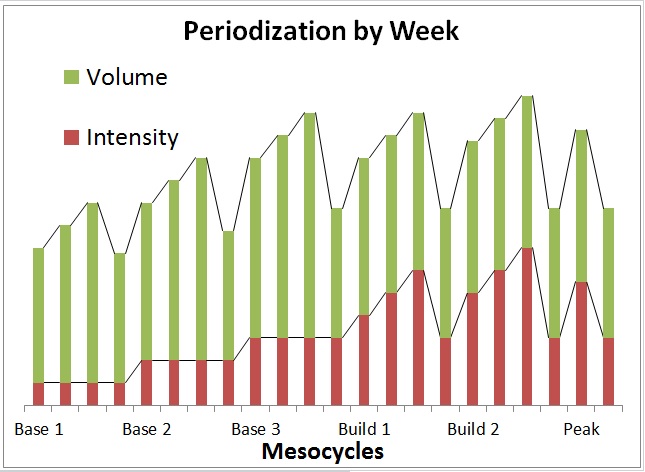Every competitive cyclist is always pushing for the best fitness at important points in the season. The key to achieving that fitness is a training plan based on periodization. What is periodization? How can you use it to become as strong and as fast as possible for the most important events?
Old School versus New School
Eddy Merckx was able to race whenever, wherever, and still win. Race into shape, get behind the derny (moto) and will your body into fitness. Those days are long gone. Today’s cyclists choose their races and build up peak fitness to targeted times in the season. Now it is rare to see the superstars of the sport very much before their key events. They race a few carefully selected races that fit in with their periodized program. What are they doing between the infrequent races? Training meticulously to the demands of their chosen races.
What is Periodization?
Periodization in cycling is a series of micro and mesocycles that allow the body to build fitness and then recover from the workload that it went through. Without that recovery, training is useless. Recovery is when the body overcompensates for the training stress and makes the body stronger. Without a high enough workload that over-stresses the body, it does not need to compensate for the work that the rider has done. Periodization strikes a balance of work and recovery in a systematic plan throughout the season to make the body stronger.
Throughout the periodized training plan, the rider will build upon work done in previous cycles. There is no plateauing because of the differing training from week to week. Every few weeks, there are higher levels of intensity and/or volume included.
There are different approaches to periodization. All methods aim to achieve peak fitness at key points in the season. This article will cover the most common form, put forth by Joe Friel, one of the leaders in methodical training.
Planning Your Calendar – The Macrocycle
Take a look at your season’s calendar. Fill in every race you would like to do. Now assign a priority to them; 3 for low priority races that you will train through, 2 for medium priority races that you will come to with a bit of freshness, and 1 for highest priority races that you will be fresh and super-fit for. You should have a lot of 3’s, some 2’s and a few 1’s. Ideally the priority 1 races are within a few weeks of one another. This will allow you to have peak fitness without all of your hopes for the season riding on one race. If you have an inopportune flat or mechanical, you will still have a few races where you have great fitness.
Mesocycles
Now that you have the key 3 or 4 weeks of the season that you want to be super fit for, you can work backwards to fill in your mesocycles. The week before your first priority 1 race will be a PEAK period and so will the next 2 or 3 weeks after with the next few priority 1 races. Your goal in the PEAK period is to maintain your sharp fitness with a few very hard intervals with plenty of recovery.
Now block off the 22 weeks leading up to your first PEAK week. That first week is the beginning of your training block. Each of the next five cycles is four weeks long, with building volume and/or intensity until you get to the final week, which is a rest week. In that week you knock down the volume and intensity and allow your body to recover. Each one of these weeks are your microcycles.
BASE 1
In BASE 1 you lay the foundation for the whole season. You should do a lot of cadence work, both low rpm’s to build strength, and high rpm’s to build muscle memory, along with a bit of max rpm work. The max rpm work will lay the foundation for a good sprint later in the season. You also do a lot of work at endurance pace to rebuild the capillaries for good oxygen transport to the muscles.
BASE 2
You will continue working on everything you did in BASE 1 and add in some tempo work. Additionally you will start to do some sprinting beyond the max rpm workouts to really develop that snap that many, many cyclists lack. Volume also goes up if you can fit it into your schedule.
BASE 3
This is when you start to get some intensity with work at threshold. The highest training volume of the season happens during these three weeks of work. Generally racing starts around this time too, but that also depends when your PEAK is. Be sure to plan your training accordingly and account for the training load of whatever races you may have.
BUILD 1
The BUILD 1 period is when you start focusing in on your high-intensity limiters as a cyclist. Could your sprint use a lot more work? Do you get dropped from breakaways? Are your time trials weak? Work hard on your weaknesses here while building up your high intensity zones.
BUILD 2
Continue with the work you have done in BUILD 1 with higher intensity and more interval volume. These last two blocks are very demanding. Make sure you get enough recovery.
PEAK
The last mesocycle of the macrocyle is the PEAK. You transition from working on your weaknesses to working on your strengths at a very high intensity. This will be your final preparation before you hit your key events and your RACE period.
Putting it Together
There are a lot of different workouts to do in each mesocycle. Knowing “what is periodization” in cycling gives a great outline to get started and not plateau during the season, helping you to achieve optimal fitness at the right time for your key events.
